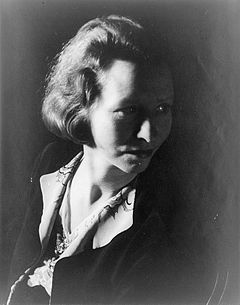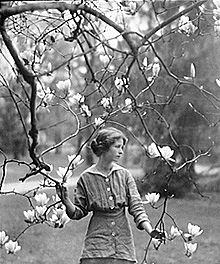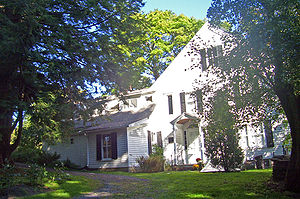- Edna St. Vincent Millay
-
Edna St. Vincent Millay 
Edna St. Vincent Millay,
photographed by Carl Van Vechten, 1933Born February 22, 1892
Rockland, MaineDied October 19, 1950 (aged 58)
Austerlitz, New YorkPen name Nancy Boyd Occupation poet Nationality American Edna St. Vincent Millay (February 22, 1892 – October 19, 1950) was an American lyrical poet, playwright and feminist.[1] She received the Pulitzer Prize for Poetry,[2] and was known for her activism and her many love affairs. She used the pseudonym Nancy Boyd for her prose work. The poet Richard Wilbur asserted, "She wrote some of the best sonnets of the century."[3]
Contents
Life
Early life
Millay was born in Rockland, Maine to Cora Lounella, a nurse, and Henry Tollman Millay, a schoolteacher who would later become superintendent of schools. Her middle name derives from St. Vincent's Hospital in New York, where her uncle's life had been saved just before her birth. The family's house was "between the mountains and the sea where baskets of apples and drying herbs on the porch mingled their scents with those of the neighboring pine woods."[4] In 1904, Cora officially divorced Millay's father for financial irresponsibility, but they had already been separated for some years. Cora and her three daughters, Edna (who called herself "Vincent"), Norma, and Kathleen, moved from town to town, living in poverty. Cora travelled with a trunk full of classic literature, including Shakespeare and Milton, which she read to her children. The family settled in a small house on the property of Cora's aunt in Camden, Maine, where Millay would write the first of the poems that would bring her literary fame.
The three sisters were independent and spoke their minds, which did not always sit well with the authority figures in their lives. Millay's grade school principal, offended by her frank attitudes, refused to call her Vincent. Instead, he called her by any woman's name that started with a V.[5] At Camden High School, Millay began developing her literary talents, starting at the school's literary magazine,The Megunticook. At 14 she won the St. Nicholas Gold Badge for poetry, and by 15 she had published her poetry in the popular children's magazine St. Nicholas, the Camden Herald, and the high-profile anthology Current Literature. While at school she had several relationships with women, including Edith Wynne Matthison, who would go on to become an actress in silent films.[6] Millay entered Vassar College at 21, later than usual, and had relationships with several fellow students during her time there.[5] In January, 1921, she went to Paris, where she met and befriended the sculptor Thelma Wood.[7]
Millay’s fame began in 1912 when she entered her poem “Renascence” in a poetry contest in The Lyric Year. The poem was widely considered the best submission and when it was ultimately awarded fourth place, it created a scandal which brought Millay publicity. The first-place winner Orrick Johns was among those who felt that “Renascence” was the best poem, and stated that “the award was as much an embarrassment to me as a triumph." A second-prize winner offered Millay his $250 prize money.[8] In the immediate aftermath of the Lyric Year controversy, Caroline B. Dow heard Millay reciting her poetry and playing the piano at the Whitehall Inn in Camden, Maine, and was so impressed that she offered to pay for Millay’s education at Vassar College. Millay moved to New York City after her graduation in 1917.
Career
Further information: Edna St. Vincent Millay bibliographyMillay lived in a number of places in Greenwich Village, including a house owned by the Cherry Lane Theatre, renowned for being the smallest in New York City.[9] The critic Floyd Dell wrote that the red-haired and beautiful Millay was "a frivolous young woman, with a brand-new pair of dancing slippers and a mouth like a valentine."[4] Millay described her life in New York as "very, very poor and very, very merry." Openly bisexual, she counted among her close friends the writers Witter Bynner, Arthur Davison Ficke, and Susan Glaspell, as well as Floyd Dell and the critic Edmund Wilson, both of whom proposed marriage to her and were refused.[6][10]
Her 1920 collection A Few Figs From Thistles drew controversy for its novel exploration of female sexuality and feminism.[11] In 1921 she wrote the anti-war play Aria da Capo. Millay won the Pulitzer Prize for Poetry in 1923 for "The Ballad of the Harp-Weaver".[12] She was only the third woman to win the poetry prize.[2]
In 1923 she married 43-year-old Eugen Jan Boissevain (1880–1949), the widower of the labor lawyer and war correspondent Inez Milholland, a political icon Millay had known while living in Greenwich Village. A self-proclaimed feminist, Boissevain supported her career and took primary care of domestic responsibilities. Both Millay and Boissevain had other lovers throughout their twenty-six-year marriage. Millay's most significant such relationship during this time was with the poet George Dillon, who was fourteen years her junior, and for whom she wrote a number of her sonnets.
In 1925, Boissevain and Millay bought Steepletop near Austerlitz, New York, which had been a 635-acre (257 ha) blueberry farm.[13] The couple built a barn (from a Sears Roebuck kit), and then a writing cabin and a tennis court. Millay grew her own vegetables in a small garden.[13][14] The couple later bought Ragged Island in Casco Bay, Maine, as a summer retreat.[15]
Millay's reputation was damaged by the poetry she wrote about the Allied war effort during World War II. Merle Rubin noted: "She seems to have caught more flak from the literary critics for supporting democracy than Ezra Pound did for championing fascism." In the New York Times Millay mourned the Czechoslovak city of Lidice, the site of a Nazi massacre:
The whole world holds in its arms today
The murdered village of Lidice,
Like the murdered body of a little child.[4]In 1943 Millay was the sixth person and the second woman to be awarded the Frost Medal for her lifetime contribution to American poetry. Boissevain died in 1949 of lung cancer, and Millay lived alone for the last year of her life.
Death and Steepletop legacy
Millay died at her home on October 19, 1950. She had fallen down stairs and was found approximately eight hours after her death. Her physician reported that she had had a heart attack following a coronary occlusion.[4][16][17] She was 58 years old.
Millay's sister Norma and her husband, the painter and actor Charles Frederick Ellis, moved to Steepletop after Millay's death. In 1973 they established Millay Colony for the Arts on the seven acres (2.8 ha) around the house and barn. After the death of her husband in 1976, Norma continued to run the program until her death in 1986.[13] At 17, the poet Mary Oliver visited Steepletop and became a close friend of Norma. Oliver eventually lived there for seven years and helped to organise Millay's papers.[18] Mary Oliver herself went on to become a Pulitzer Prize-winning poet, greatly inspired by Millay's work.[19] In 2006, the state of New York paid $1.69 million to acquire 230 acres (0.93 km2) of Steepletop, with the intention to add the land to a nearby state forest preserve. The proceeds of the sale were to be used to restore the farmhouse and turn it into a museum. Parts of the grounds of Steepletop, including a Poet's Walk that leads to Millay's grave, are now open to the public.
Works
My candle burns at both ends;
It will not last the night;
But ah, my foes, and oh, my friends—
It gives a lovely light!“”"First Fig"
from A Few Figs from Thistles (1920) [20]Millay wrote five verse dramas early in her career, including Two Slatterns and a King and The Lamp and the Bell, a poem written for Vassar College about love between women.[6] She was commissioned by the Metropolitan Opera House to write a libretto for an opera composed by Deems Taylor. The result, The King's Henchman, drew on the Anglo-Saxon Chronicle's account of Eadgar, King of Wessex, and was described as the most effectively and artistically wrought American opera ever to reach the stage. Within three weeks her publishers had run through four editions of the book.[4]
Her pacifist verse drama Aria da Capo, a one-act play written for the Provincetown Players, is often anthologized. It aired live as an episode of Academy Theatre in 1949 on NBC.
"Euclid alone has looked on Beauty bare" (1922) is an homage to the Geometry of Euclid.[21] "Renascence"[22] and "The Ballad of the Harp-Weaver"[23] are often considered her finest poems. On her death, The New York Times described her as "an idol of the younger generation during the glorious early days of Greenwich Village [...] One of the greatest American poets of her time."[4] Thomas Hardy said that America had two great attractions: the skyscraper and the poetry of Edna St. Vincent Millay.
Publications
Poetry collections
- Renascence, and Other Poems (title poem first published under name E. Vincent Millay in The Lyric Year, 1912; collection includes God's World), M. Kennerley, 1917. reprinted, Books for Libraries Press, 1972.
- A Few Figs From Thistles: Poems and Four Sonnets, F. Shay, 1920, second [enlarged] edition published as A Few Figs From Thistles: Poems and Sonnets,F. Shay, 1921.
- Second April (poems; includes Spring, Ode to Silence,and The Beanstalk), M. Kennerley, 1921. reprinted, Harper, 1935
- The Ballad of the Harp-Weaver, F. Shay, 1922, reprinted as The Harp-Weaver, in The Harp-Weaver, and Other Poems (includes The Concert, Euclid Alone has Looked on Beauty Bare, and Sonnets from an Ungrafted Tree), Harper, 1923.
- Poems, M. Secker, 1923.
- (Under pseudonym Nancy Boyd) Distressing Dialogues, preface by Edna St. Vincent Millay, Harper, 1924.
- The Buck in the Snow, and Other Poems (includes The Buck in the Snow [also see below] and On Hearing a Symphony of Beethoven), Harper, 1928.
- Fatal Interview (sonnets), Harper, 1931.
- Wine from These Grapes (poems; includes Epitaph for the Race of Man and In the Grave No Flower), Harper, 1934.
- (Translator with George Dillon; and author of introduction) Charles Baudelaire, Flowers of Evil, Harper, 1936.
- Conversation at Midnight (narrative poem), Harper, 1937.
- Huntsman, What Quarry? (poems), Harper, 1939.
- There Are No Islands, Any More: Lines Written in Passion and in Deep Concern for England, France, and My Own Country, Harper, 1940.
- Make Bright the Arrows: 1940 Notebook (poems), Harper, 1940.
- The Murder of Lidice (poem), Harper, 1942.
- Second April [and] The Buck in the Snow, introduction by William Rose Benét, Harper, 1950.
- Mine the Harvest (poems), edited by Norma Millay, Harper, 1954.
- Take Up the Song, Harper, 1986, reprinted with music by William Albright as Take Up the Song: Soprano Solo, Mixed Chorus, and Piano, Henmar Press, 1994.
- Selected Poems/The Centenary Edition, edited by Colin Falck, Harper Perennial, 1992.
Plays
- (And director) Aria da capo (one-act play in verse; first produced in Greenwich Village, NY, December 5, 1919), M. Kennerley, 1921 (also see below).
- The Lamp and the Bell (five-act play; first produced June 18, 1921), F. Shay, 1921 (also see below).
- Two Slatterns and a King: A Moral Interlude (play), Stewart Kidd, 1921.
- Three Plays (contains Two Slatterns and a King, Aria da capo, and The Lamp and the Bell), Harper, 1926.
- (Author of libretto) The King's Henchman (three-act play; first produced in New York, February 17, 1927), Harper, 1927.
- The Princess Marries the Page (one-act play), Harper, 1932.
Letters
- Letters of Edna St. Vincent Millay, edited by Allan Ross Macdougall, Harper, 1952.
References
- ^ Obituary Variety, October 25, 1950.
- ^ a b Pulitzer site Retrieved December 9, 2010
- ^ Millay, Edna St. Vincent. Selected Poems. Harper Collins, 1991
- ^ a b c d e f New York Times Obituary October 20, 1950 "Edna St. V. Millay Found Dead At 58". Accessed 2010-09-13
- ^ a b Epstein, Daniel Mark (2001). What Lips My Lips Have Kissed: The Loves and Love Poems of Edna St. Vincent Millay. New York: Henry Holt. ISBN 0805067272.
- ^ a b c Millay biography from the Academy of American Poets
- ^ Herring, Phillip (1995). Djuna: The Life and Work of Djuna Barnes. New York: Penguin Books. pp. 158. ISBN 0140178422.
- ^ Dash, Joan (1973). A Life of One’s Own: Three Gifted Women and the Men They Married. New York: Harper and Row, Publishers.
- ^ Nevius, Michelle and James (2009). Inside the Apple: A Streetwise History of New York City. New York: Free Press.
- ^ Milford, Nancy (2001). Savage Beauty: The Life of Edna St. Vincent Millay. New York: Random House. pp. 191–192. ISBN 0375760814.
- ^ Millay, Edna St. Vincent. A few Figs from Thistles
- ^ Millay, Edna St. Vincent, "The Ballad of the Harp-Weaver"
- ^ a b c "History". Millay Colony for the Arts. http://www.millaycolony.org/history. Retrieved January 23, 2010.
- ^ "The Grounds at Steepletop". Edna St. Vincent Millay Society. 2008. http://www.millaysociety.org/millaystpgrounds.htm. Retrieved January 23, 2010.
- ^ Milford, Nancy. (2001) Savage Beauty: The Life of Edna St. Vincent Millay. Random House.
- ^ Milford (2001) p508
- ^ Epstein (2001) p273.
- ^ "The Land and Words of Mary Oliver, the Bard of Provincetown" July 5, 2009 New York Times. Accessed 2010-09-07
- ^ Poetry Foundation Oliver biography. Accessed 2010-09-07
- ^ Michael Browning (18 August 1996). "The Eternal Flame". The Miami Herald. http://www.tropicfan.com/The%20Eternal%20Flame%20by%20Michael%20Browning.htm.
- ^ Sinclair, N. et al. (2006). Mathematics and the Aesthetic. New York: Springer. p. 111.
- ^ Millay, Edna St. Vincent. "Renascence"
- ^ Millay, Edna St. Vincent. "The Ballad of the Harp-Weaver"
Further reading
- Barnet, Andrea (2004). All-Night Party: The Women of Bohemian Greenwich Village and Harlem, 1913-1930. Chapel Hill, NC: Algonquin Books. ISBN 1-56512-381-6.
- Epstein, Daniel Mark (2001). What Lips my Lips Have Kissed: The Loves and Love Poems of Edna St. Vincent Millay. New York: Henry Holt. ISBN 0805067272.
- Milford, Nancy (2001). Savage Beauty: The Life of Edna St. Vincent Millay. New York: Random House. pp. 191–192. ISBN 0375760814.
- Millay, Edna St. Vincent (1991) Selected Poems. Harper Collins
External links
- Edna St. Vincent Millay at the Poetry Foundation.
- Selected Poetry of Edna St. Vincent Millay - Biography & 18 poems (Ashes of Life, The Betrothal, Departure, Dirge, Ebb, Feast, First Fig, [Four Sonnets 1922], Grown Up, Humoresque, Lament, The Penitent, Recuerdo, Second Fig, Sonnets 1923, Sonnets from an Ungrafted Tree, Sorrow, Spring)
- Works by Edna St. Vincent Millay at Project Gutenberg
- Edna Millay's Gravesite. Accessed 2010-09-13
- Edna St. Vincent Millay Society. Accessed 2010-09-13
- Archive and images at the Smithsonian Institute.
- LibriVox, Millay audio files in the public domain. Accessed 2010-09-13
- New York Times Obituary October 20, 1950 "Edna St. V. Millay Found Dead At 58". Accessed 2010-09-13
Vassar College Campus Main Building • Frances Lehman Loeb Art Center • Strong House • Thompson Memorial Library • Vassar Chapel • Vassar College ObservatoryStudent Life People Matthew Vassar • Elizabeth Bentley • Cappy Hill • Edna St. Vincent Millay • Maria Mitchell • Meryl Streep • List of Vassar College peopleNamesakes Pulitzer Prize for Poetry (1922–1950) - Edwin Arlington Robinson (1922)
- Edna St. Vincent Millay (1923)
- Robert Frost (1924)
- Edwin Arlington Robinson (1925)
- Amy Lowell (1926)
- Leonora Speyer (1927)
- Edwin Arlington Robinson (1928)
- Stephen Vincent Benét (1929)
- Conrad Aiken (1930)
- Robert Frost (1931)
- George Dillon (1932)
- Archibald MacLeish (1933)
- Robert Hillyer (1934)
- Audrey Wurdemann (1935)
- Robert P. T. Coffin (1936)
- Robert Frost (1937)
- Marya Zaturenska (1938)
- John Gould Fletcher (1939)
- Mark Van Doren (1940)
- Leonard Bacon (1941)
- William Rose Benét (1942)
- Robert Frost (1943)
- Stephen Vincent Benét (1944)
- Karl Shapiro (1945)
- Robert Lowell (1947)
- W. H. Auden (1948)
- Peter Viereck (1949)
- Gwendolyn Brooks (1950)
- Complete list
- (1922–1950)
- (1951–1975)
- (1976–2000)
- (2001–2025)
Categories:- 1892 births
- 1950 deaths
- Accidental deaths from falls
- Accidental deaths in New York
- American poets
- Formalist poets
- American women writers
- Bisexual writers
- LGBT writers from the United States
- People from Greenwich Village, New York
- People from Rockland, Maine
- Pulitzer Prize for Poetry winners
- Sonneteers
- Vassar College alumni
- Writers from Maine
- Women poets
- Opera librettists
- American librettists
- People from Camden, Maine
Wikimedia Foundation. 2010.


